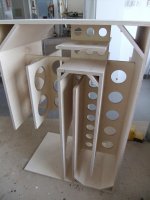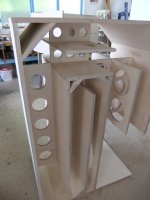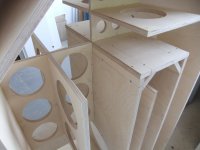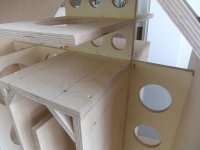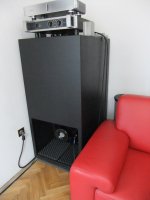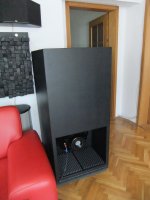Next simulation, stepped vs exp.
Gray is a five segment exponential-segment horn which approximates an
exponential curve, i.e. equal to a 1-segment exp. horn. The black is a five
segment stepped horn of the same volume and length. Less than a dB in
difference at the frequenses of usage, i.e. below ~170 Hz. The stepped
horn has higher sensitivity at lower freq. bot lower at higher freq. than the
pure exponential horn.
Nice work.
As I said though, if the horn was tuned lower and you wanted to use it up to 120 hz or so a lot of the more noticeable divergences would be right inside the passband. That 2.5 db difference would be right inside the passband and the big 3 db difference would be right at the edge of the passband.
Last edited:
I guess we interpret things differently. I see very close to 1 db difference at the low knee AND the low knee is shifted a couple of hz.
Which could be as a result of over-estimating the path length. I quote from Petter's post "I have calculated the horn path length according to the summed segment lengths. I know you're supposed to do a mid-way in the turns but this makes it so much easier and I doubt the differences are gigantic". If the path length estimate is off by a few percent, then the knee will be shifted a bit too.
And then starting at 80 hz and up the correlation is terrible with up to 3 db differences
Are we looking at the same graph? You realize the vertical axis is in 2dB steps, right? At a 100 Hz, the graph is showing a discrepancy of a dB or less, certainly nowhere near 3dB. At 80 Hz the response is identical. The correlation within the passband of what one would consider a basshorn up to the 1/4W "limit" due to the length of the steps is IMO more than good enough for any design work IMO.
This is not a good correlation at all if you value accurate simulation IMO and if you want to build it stepped you should simulate it as stepped.
Hey, since none of these include the effects of the speaker grill or handles or braces that will appear in an actual build, that makes them all useless as "accurate" simulations of a planned build, right?
IMO the correlation is good enough for anyone interesting in actually building and using these things, rather than wondering about a fraction of a dB here or there in the passband displayed on a computer screen. YMMV.
Which could be as a result of over-estimating the path length. I quote from Petter's post "I have calculated the horn path length according to the summed segment lengths. I know you're supposed to do a mid-way in the turns but this makes it so much easier and I doubt the differences are gigantic". If the path length estimate is off by a few percent, then the knee will be shifted a bit too.
I took his quote to mean that he used centerline measurements, not advanced centerline. if he did the same thing with both the expanding and stepped sims then the sims are comparable - zero percent path length error between them.
Are we looking at the same graph? You realize the vertical axis is in 2dB steps, right? At a 100 Hz, the graph is showing a discrepancy of a dB or less, certainly nowhere near 3dB. At 80 Hz the response is identical. The correlation within the passband of what one would consider a basshorn up to the 1/4W "limit" due to the length of the steps is IMO more than good enough for any design work IMO.
I don't know what you are looking at but I see a 2.5 db difference at 200 hz and a 3 db difference at about 260.
I was VERY clear that if the horn was tuned lower and the passband was 20 - 120 hz these big differences would be right in the passband (the top one would be right at the edge of the passband). 20 hz horns are pretty popular, especially the tapped variety. Just because this example happens to be a high tuned horn with a small intended passband doesn't mean we shouldn't examine the entire 3 octave range that horns are capable of. So we should be looking at the range from 40 to 320 hz at least. If you do the example with a lower tuned horn and inspect the full 3 octaves of performance the larger divergences are now inside the passband.
Hey, since none of these include the effects of the speaker grill or handles or braces that will appear in an actual build, that makes them all useless as "accurate" simulations of a planned build, right?
IMO the correlation is good enough for anyone interesting in actually building and using these things, rather than wondering about a fraction of a dB here or there in the passband displayed on a computer screen. YMMV.
This isn't about an actual build, it's a study of an expanding flare vs a stepped flare, and the correlation is not very good.
Horns are capable of 3 octaves of output. Just because you don't want to use the whole 3 octaves doesn't mean we can disregard the differences that are clearly there. Again, this is a study to see how close these two things sim, and over the course of the full 3 octaves the answer is not very well.
Last edited:
I took his quote to mean that he used centerline measurements, not advanced centerline. if he did the same thing with both the expanding and stepped sims then the sims are comparable - zero percent path length error between them.
The only way to be sure they're the path length is the same for both sims is to actually calculate the path length for both sims. I think you're making a huge assumption there.
I don't know what you are looking at but I see a 2.5 db difference at 200 hz and a 3 db difference at about 260.
First of all, you previously claimed that the difference was 3dB at 80 Hz. Go back and read your own post if you need confirmation.
Secondly, by now pointing out that the "big differences" are at 200 Hz and above, rather than at the 80 Hz you previously mentioned, you are actually reinforcing my point (thank you!) as these are all *at or above* the 1/4W guide I've previously referred to for estimating where the impact of the segment length on the sim will occur.
I was VERY clear that if the horn was tuned lower and the passband was 20 - 120 hz these big differences would be right in the passband (the top one would be right at the edge of the passband).
IMO that would happen only if the lengths of any of the segments fell within the 1/4W guide that I have previously referred to. Make sure you use segments that are short enough so their effect on the FR falls outside of the passband and don't have to worry about the passband being adversely affected.
Again, this is a study to see how close these two things sim, and over the course of the full 3 octaves the answer is not very well.
...because the length of the segments does not allow this for the example given - according to exactly the same 1/4W guide I've referred to previously! Their impact starts around 120 Hz and above, based on the length of the longest segment. If you want to design a stepped basshorn to do up to 200 Hz, then if you're going to step it, make sure no "step" in the build is longer than 34500/(4*200)=43 cm. That will push the response variations out of the design passband, and you can use a constant flare sim in HornRep to sim what the result will be like.
The only way to be sure they're the path length is the same for both sims is to actually calculate the path length for both sims. I think you're making a huge assumption there.
Segment length is entered manually, it's not calculated by the sim. Doing a comparison that isn't already folded would have made this a moot point, but since it appears he simulated an existing folded design he had to calculate the path length using centerline or advanced centerline method. If that's not what he's talking about then I'm not sure what he's saying.
First of all, you previously claimed that the difference was 3dB at 80 Hz. Go back and read your own post if you need confirmation.
Absolutely not, I did not say that. Here's what I said word for word. You even quoted it yourself but apparently didn't read it very carefully.
"And then starting at 80 hz and up the correlation is terrible with up to 3 db differences ..."
I'm not sure how that could possibly be confused but to break it down - above 80 hz the lines start to diverge and up higher in frequency there are differences of up to 3 db. Clearly there's no 3 db difference at 80 hz, why would I say there was? There's only one place on the graph where the difference is 3 db.
Secondly, by now pointing out that the "big differences" are at 200 Hz and above, rather than at the 80 Hz you previously mentioned, you are actually reinforcing my point (thank you!) as these are all *at or above* the 1/4W guide I've previously referred to for estimating where the impact of the segment length on the sim will occur.
Again you continue to completely disregard the almost 1 db difference AND the 2 hz frequency shift at the low knee. That's pretty significant. You can ignore it if you want to but it is clearly there and that's WAY below the 1/4 wave length of the segments.
IMO that would happen only if the lengths of any of the segments fell within the 1/4W guide that I have previously referred to. Make sure you use segments that are short enough so their effect on the FR falls outside of the passband and don't have to worry about the passband being adversely affected.
...because the length of the segments does not allow this for the example given - according to exactly the same 1/4W guide I've referred to previously! Their impact starts around 120 Hz and above, based on the length of the longest segment. If you want to design a stepped basshorn to do up to 200 Hz, then if you're going to step it, make sure no "step" in the build is longer than 34500/(4*200)=43 cm. That will push the response variations out of the design passband, and you can use a constant flare sim in HornRep to sim what the result will be like.
You can do an example if you like but you will find that unless you use more than 6 segments you are not going to get a good correlation.
Last edited:
above 80 hz the lines start to diverge and up higher in frequency there are differences of up to 3 db.
Yup, at and above where the 1/4W guide estimates there will be. 200 Hz and above. Oh, and there are two segments that are 64cm and 66cm long - their effects will be noticeable around 130 Hz. Have a look at a graph again and see if something sticks out at you in that particular location.
Again you continue to completely disregard the almost 1 db difference AND the 2 hz frequency shift at the low knee.
No, you've just chosen to completely disregard the possible explanation I gave for that observation. I don't think that it's completely accurate to just draw out a stepped horn in a straight line and take the path length from that, as each discontinuity going from step to step is going to impact the effective path length, and in a way that's not predicted by the "advanced centerline method" (because there are no bends to apply it to, LOL). And I don't know a means of estimating the impact on path length of a discontinuity. We do have a means of making an estimate for the path length around a bend however, so my suggestion would be to derive it from the plan for the horn.
In any case, I'd like to see the impedance curve for the sim, to see exactly how much that frequency shift actually is.
Yup, at and above where the 1/4W guide estimates there will be. 200 Hz and above. Oh, and there are two segments that are 64cm and 66cm long - their effects will be noticeable around 130 Hz. Have a look at a graph again and see if something sticks out at you in that particular location.
A 3 octave span for a 40 hz low knee is 320 hz. He used 5 segments. A lower tuned horn is going to be longer than this one. Unless you use more than 6 segments you will not get a good correlation. For a 450 cm path length, assuming 50 cm steps you need 9 segments. This is what I've been saying - you need more than 6 steps to get a good correlation and that's going to be especially true for longer lower tuned horns.
No, you've just chosen to completely disregard the possible explanation I gave for that observation. I don't think that it's completely accurate to just draw out a stepped horn in a straight line and take the path length from that, as each discontinuity going from step to step is going to impact the effective path length, and in a way that's not predicted by the "advanced centerline method" (because there are no bends to apply it to, LOL). And I don't know a means of estimating the impact on path length of a discontinuity. We do have a means of making an estimate for the path length around a bend however, so my suggestion would be to derive it from the plan for the horn.
In any case, I'd like to see the impedance curve for the sim, to see exactly how much that frequency shift actually is.
For the sake of this exercise it doesn't make any difference at all how he reverse engineered the fold.
As long as he used the same segment lengths in both the simulated comparisons then the comparisons are completely valid. This is exactly why I like to show all my work. If Peter showed all his work I can almost 100 percent guarantee that he used the same segment lengths for the expanding and the stepped versions so they are valid and comparable with zero percent chance of error in path length.
For example - segment length of expanding segment 1 = 41.8 cm
- segment length of stepped segment 1 = 41.8 cm
It makes absolutely no difference how he came up with 41.8 cm as long as it's the same in both sim examples.
Last edited:
A 3 octave span for a 40 hz low knee is 320 hz. He used 5 segments. A lower tuned horn is going to be longer than this one. Unless you use more than 6 segments you will not get a good correlation. For a 450 cm path length, assuming 50 cm steps you need 9 segments. This is what I've been saying - you need more than 6 steps to get a good correlation and that's going to be especially true for longer lower tuned horns.
...and I've been saying that you can use the 1/4W guide to figure out the minimum amount of steps required to ensure any response variation falls outside of the required passband. You don't have to "guess" at a number of steps, like "6", which will *still* result in the frequency where the response starts to deviate being shifting downwards as the horn is lengthened. The 1/4 wave guide will give you the minimum number of segments required to keep the variations out of horn's passband, and it's a very simple one to follow - take the upper frequency you want the horn to reach, then it's 34500/(F*4) to give you the maximum segment length in cm, then divide the path length by that.
For the sake of this exercise it doesn't make any difference at all how he reverse engineered the fold.
We will have to disagree on that point. I think the path length is going to be affected by any discontinuity in the horn, be it a bend or going from one segment to another without smooth expansion, so even simming it as all segments connected in a straight line may be somewhat problematic. Logic suggests that the smaller the discontinuity, the smaller the impact however. If Petter redoes his sim with lets say half the number of stepped segments, but make each of the remaining segments twice as long to compensate, we might see another change in effective path length due to the larger discontinuities, but that's just a guess on my part.
- take the upper frequency you want the horn to reach, then it's 34500/(F*4) to give you the maximum segment length in cm, then divide the path length by that.
You are going to need a lot more steps than that to get a good correlation over a 3 octave span.
According to this formula you should be ok up to 85 hz with segments of 101.26 cm. But as we can clearly see in Petter's example his longest segment was 66.3 cm and the graphed lines start to diverge at 85 hz (not even counting the divergences all the way down at the low knee). So the 1/4 wave "rule" gives segment lengths at least 1/3 too long. Even if you did go 1/3 less that the 1/4 wave "rule" I doubt you would get a good correlation at the low knee.
We will have to disagree on that point. I think the path length is going to be affected by any discontinuity in the horn, be it a bend or going from one segment to another without smooth expansion, so even simming it as all segments connected in a straight line may be somewhat problematic. Logic suggests that the smaller the discontinuity, the smaller the impact however. If Petter redoes his sim with lets say half the number of stepped segments, but make each of the remaining segments twice as long to compensate, we might see another change in effective path length due to the larger discontinuities, but that's just a guess on my part.
In a simulated comparison ALL horns have to be simulated as straight lines (non folded). if you are concerned about effects a sim might not consider you need to build two horns (expanding and stepped) and measure them.
As far as this simulated comparison goes, the horns are both considered to be non folded (there's really no way around that) and if the segment lengths are equal in both comparisons then the simulated comparisons are valid.
Last edited:
You are going to need a lot more steps than that to get a good correlation over a 3 octave span.
The number of steps required is based on the upper passband requirement for the horn, not the octave span.
According to this formula you should be ok up to 85 hz with segments of 101.26 cm. But as we can clearly see in Petter's example his longest segment was 66.3 cm and the graphed lines start to diverge at 85 hz.
There's less than a dB of variation at 100Hz, and much lower below that. The guide suggests that response variation will become significant at 130 Hz, where the sim shows that the variation is still around 1 dB or less. IMO the guide is fine for design purposes, unless you really consider a variation of less than one dB is "terrible", LOL.
In a simulated comparison ALL horns have to be simulated as straight lines (non folded).
Yup, and in those sims the fully-flared one will have no discontinuities and the stepped one will have discontinuities - at every step. I'm not aware of a "rule" that will allow us to predict the impact on the effective path length for these discontinuities, but I'm pretty sure that there will be an impact, albeit a small one. That's why I think we can get closer by simming an actual folded horn with the AC method used to measure the path length, because that's been proven to be pretty effective at estimating path length correctly. Once each stepped segment occurs after a fold, the ACM method may get us pretty close to the real length of the horn.
The number of steps required is based on the upper passband requirement for the horn, not the octave span.
True but in a comparison like this we should be looking for a 3 octave span since it is possible.
I totally concede to the fact that people might not want a 3 octave span and in that case the upper cutoff frequency is the defining limit.
There's less than a dB of variation at 100Hz, and much lower below that. The guide suggests that response variation will become significant at 130 Hz, where the sim shows that the variation is still around 1 dB or less. IMO the guide is fine for design purposes, unless you really consider a variation of less than one dB is "terrible", LOL.
Yes, I concede this too, at least at the upper end of the passband we are well within 1 db (using the 1/4 wave rule and the 66.3 longest segment length). Now that I think we are on the same page with that I'm still concerned with the difference at the low knee, both the difference in spl and the frequency shift. (And I'm not ignoring the advanced centerline issue here, it simply isn't an issue, more on that in a minute.)
Yup, and in those sims the fully-flared one will have no discontinuities and the stepped one will have discontinuities - at every step. I'm not aware of a "rule" that will allow us to predict the impact on the effective path length for these discontinuities, but I'm pretty sure that there will be an impact, albeit a small one. That's why I think we can get closer by simming an actual folded horn with the AC method used to measure the path length, because that's been proven to be pretty effective at estimating path length correctly. Once each stepped segment occurs after a fold, the ACM method may get us pretty close to the real length of the horn.
We know the sim is unfolded or straight.
We can easily build both an expanding and a stepped horn unfolded and it will be straight.
In this case the path lengths will be the same so in this case the sim will be valid.
ABSOLUTELY if you want to fold it then you should use the advanced centerline method to fold it if you want the sim to be accurate to the build plans. The centerline method will give a percentage of error between the two.
But in this case we are not folding or building anything, we are just comparing an unfolded expanding horn and an unfolded stepped horn and they both have the same path length. The simulated comparison is valid.
Last edited:
But in this case we are not folding or building anything, we are just comparing an unfolded expanding horn and an unfolded stepped horn and they both have the same path length. The simulated comparison is valid.
And therein lies the problem. We have a means of estimating path length changes around bends (the AC method). What we do NOT have is a means of estimating the impact on the effective path length when you have two segments of different cross-sections connected together in a straight line. So, we're making the *assumption* that the *effective* path length will be identical to a fully flared straight horn in the sim, when we're trying to do the comparison. This is where my concern lies.
If we're going to do a true sim of stepped vs. flared horn with the same *effective* path length, I think we should start with a known method of accurately determining the effective path length, as well as certain rules governing how the steps are chosen. I think Petter came up with a good approach for the latter. It's the former I have some concerns about. That's why I suggested that perhaps we could avoid that issue I mentioned above entirely by using the AC method to estimate the effective path length for his folded example, then using that in the sim. Basically side-stepping the discontinuity "problem" caused by two stepped segments connected in a straight line. All theoretically, of course
So, we're making the *assumption* that the *effective* path length will be identical to a fully flared straight horn in the sim, when we're trying to do the comparison. This is where my concern lies.
I think that's a really safe assumption. I don't know how a step in a straight unfolded horn could possibly affect the path length. The path length of any straight horn regardless of shape or geometry is straight down the center.
If we're going to do a true sim of stepped vs. flared horn with the same *effective* path length, I think we should start with a known method of accurately determining the effective path length, as well as certain rules governing how the steps are chosen. I think Petter came up with a good approach for the latter. It's the former I have some concerns about. That's why I suggested that perhaps we could avoid that issue I mentioned above entirely by using the AC method to estimate the effective path length for his folded example, then using that in the sim. Basically side-stepping the discontinuity "problem" caused by two stepped segments connected in a straight line. All theoretically, of course
This seems like a lot of unnecessary work unless/until there's some evidence provided that indicates that a step has any effect on path length whatsoever in an straight unfolded horn. The path lengths might change from the initially simulated values but both the stepped and flared versions would use the new path length value in the new comparison sim. Then you are right back where you started.
Last edited:
I thought it worth mentioning on here that Zivko gave me the plans for these and there are now four loaded with faital xl1600 in Manchester, UK.
They're pretty cool. Powersoft K10 powering them. Vinyl feedback at 30hz only... and when six feet in front of the stack of 4/4/3.
Other cabinets present are RCF LF18N401 loaded USB2 1x18" BPH and Community SLS920. (2x8" + 2" + 1")






They're pretty cool. Powersoft K10 powering them. Vinyl feedback at 30hz only... and when six feet in front of the stack of 4/4/3.
Other cabinets present are RCF LF18N401 loaded USB2 1x18" BPH and Community SLS920. (2x8" + 2" + 1")






Those enclosures look AWESOME!
Thanks BP1Fanatic, two more photos!
Attachments
looks great zivko! four can get absolutely wild.
I've got the last four of eight rebated ones nearly finished and another four xl1600 waiting ready.
they've been really powerful thus far when run with 18" bph from 25hz - 45hz. delay path from horn is very close to physical measurement when played with to best meet xover point.
I've tried a bunch of stuff now from...
two roots nights with 16ch wav stems mixed down live with live vocals, sax and melodica and other digital dub sets aswell as vinyl.
one night straight up ska, rock & punk bands
2x th-1819, 4x usb2, 2x sls920
one live electronica/house/techno band with just the th as infill for club band pa, and other passbands turned off. with jungle, dubwise and dancehall sets through 3x th-1819, 3x usb2 and 2x sls920 with a soundcraft si32c running both rigs through the evening and switching between for live and dj sets.
club rig is rear ported reflex with oberton d40 1" on b&c me45 and volt rv3153 double 12" and peavey hdh3 2x18" reflex so plenty of room under those for the 25-55hz range.
and this friday gone a big outing with:
4 x community sls920
6 x usb2 with rcf lf18n401
4 x th-1819 with faital xl1600
4 x logic lm12 wedges
1 x eaw jf100 + void mycro 12 drum monitor
run respectively from:
powersoft k3, k10, k20 and m50q
xover community branded oem xilica 4080 dsp at foh with
we had a mix of music throughout the night. live 7 piece dub with a lot of split channels getting mixed down and effected onstage live. male and female vocal and live bass so lots to play with an balance there.
this as well as a selection of big jungle dubplates with king yoof and cheshire cat, other drum&bass throughout the night and some dubwise.
the 20-40hz range being reproduced in such a clean way, free of harmonic resonances, really allows excellent vibe cultivation even at lower volumes and hopefully with environmental health restrictions out at festival stages too. it's been very social also as it's been easy to have an audible conversation at almost every event so far while bass presence isn't undermined.
thankyou for all your hard work zivko
I've got the last four of eight rebated ones nearly finished and another four xl1600 waiting ready.
they've been really powerful thus far when run with 18" bph from 25hz - 45hz. delay path from horn is very close to physical measurement when played with to best meet xover point.
I've tried a bunch of stuff now from...
two roots nights with 16ch wav stems mixed down live with live vocals, sax and melodica and other digital dub sets aswell as vinyl.
one night straight up ska, rock & punk bands
2x th-1819, 4x usb2, 2x sls920
one live electronica/house/techno band with just the th as infill for club band pa, and other passbands turned off. with jungle, dubwise and dancehall sets through 3x th-1819, 3x usb2 and 2x sls920 with a soundcraft si32c running both rigs through the evening and switching between for live and dj sets.
club rig is rear ported reflex with oberton d40 1" on b&c me45 and volt rv3153 double 12" and peavey hdh3 2x18" reflex so plenty of room under those for the 25-55hz range.
and this friday gone a big outing with:
4 x community sls920
6 x usb2 with rcf lf18n401
4 x th-1819 with faital xl1600
4 x logic lm12 wedges
1 x eaw jf100 + void mycro 12 drum monitor
run respectively from:
powersoft k3, k10, k20 and m50q
xover community branded oem xilica 4080 dsp at foh with
we had a mix of music throughout the night. live 7 piece dub with a lot of split channels getting mixed down and effected onstage live. male and female vocal and live bass so lots to play with an balance there.
this as well as a selection of big jungle dubplates with king yoof and cheshire cat, other drum&bass throughout the night and some dubwise.
the 20-40hz range being reproduced in such a clean way, free of harmonic resonances, really allows excellent vibe cultivation even at lower volumes and hopefully with environmental health restrictions out at festival stages too. it's been very social also as it's been easy to have an audible conversation at almost every event so far while bass presence isn't undermined.
thankyou for all your hard work zivko
An externally hosted image should be here but it was not working when we last tested it.
An externally hosted image should be here but it was not working when we last tested it.
- Status
- This old topic is closed. If you want to reopen this topic, contact a moderator using the "Report Post" button.
- Home
- Loudspeakers
- Subwoofers
- Tapped Horn TH-121 build
